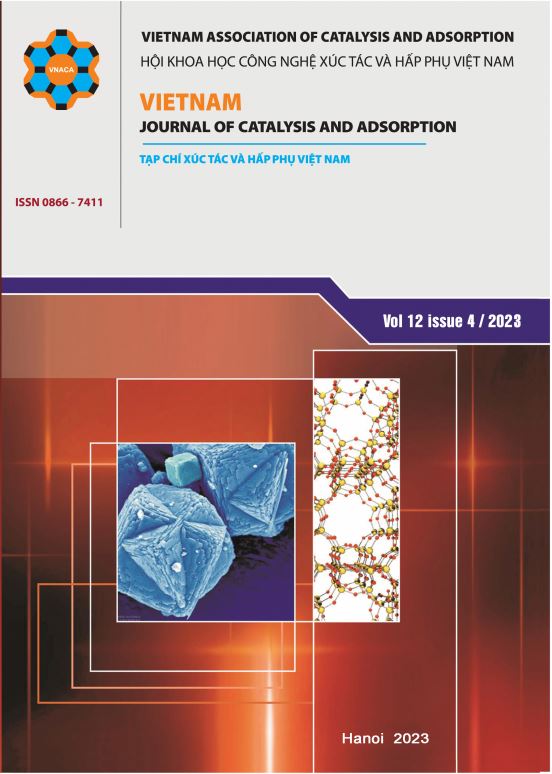Study on the ability to remove azo dyes of the metal-organic framework material MIL-101(Cr)
DOI:
https://doi.org/10.62239/jca.2023.074Keywords:
Metal-organic framework, remove organic dyes, environment treatmentAbstract
MIL-101(Cr) is formed from 1,4- benzene dicarboxylate and chromium trimer bridges and possesses a zeotype and medium pore structure along with a large BET-specific surface area, the bases for it to be a leading material in environmental remediation applications. This study synthesized the MIL-101(Cr) metal-organic framework using the hydrothermal method. The formed materials have sharp crystalline morphology octahedral size from 100-300 nm. XRD plot showing peaks at 21.10o and 26,73o assigned to MIL-101(Cr). The surface area of this material calculated by the N2 adsorption isotherm method gives the result of ~ 2,900 m2/g. This material can remove organic dyes by the simultaneous photocatalytic adsorption mechanism. The ability to remove methyl orange at an initial concentration of 10 ppm was over 90%.
Downloads
References
V.N. An, V.T.H. Hoa, L.V. Hiếu, Tạp chí Khoa học Đại học Đồng Tháp 9(3) (2020) 41-51.
L.D.P. Nhung, T.T.B. Phượng, L..V. Tân, T. Thành, Tạp chí Tài nguyên và Môi trường 1(4) (2021) 18-19.
B.X. Hiếu, T.N. Tuấn, L.H. Khoa, N.T.H. Phương, N.T.H. Phượng, Đ.T. Dũng, T.X. Tùng, T.V. Chinh, L.Đ. Dương, Tạp chí Xúc tác và Hấp phụ Việt Nam 8(2) (2019) 57-61.
T.N. Tuấn, N.T. Thịnh, T.V. Chinh, L.Đ. Dương, N.T.H. Phượng, N.T.H. Phương, Tạp chí Xúc tác và Hấp phụ Việt Nam 8(1) (2019) 110-114.
E.V. Butyrskaya, Mat. To. Com 33 (2022) 104327. https://doi.org/10.1016/j.mtcomm.2022.104327.
H.L. Hung, T. Iizuka, X. Deng, Q. Lyu, C.H. Hsu, N. Oe, L.C. Lin, N. Hosono, D.Y. Kang, Sep. Pur. Tec 310 (2023) 123115. https://doi.org/10.1016/j.seppur.2023.123115.
J. Parikh, B. Mohan, K. Bhatt, N. Patel, S. Patel, A. Vyas, K. Modi, Mic. Jou 184 (2023) 108156. https://doi.org/10.1016/j.microc.2022.108156.
W. Niu, K. Kang, Y. Ou, Y. Ding, B. Du, X. Guo, Y. Tan, W. Hu, C. Gao, Y. He, Y. Guo, Sen. Act: B. Che 381 (2023) 133347.https://doi.org/10.1016/j.snb.2023.133347.
N.T.H. Phuong, L.T. Bac, N.D. Ha and L.D. Duong, ACS Omega, 6 (2021) 33419-33427. https://doi.org/10.1021/acsomega.1c03951.
L.T. Bac, N.Q. Chau, N.T. Phuong, N.D. Ha, L.M. Tri, N.T.H. Phuong, L.D. Duong, ACS Omega 7 (2022) 46674-46681. https://doi.org/10.1021/acsomega.2c05614.
A. N. Amenaghawon, C. L. Anyalewechi, O. U. Osazuwa, E. A. Elimian, S. O. Eshiemogie, P. K. Oyefolu, H. S. Kusuma, Sep. Pur. Tec 311 22-30. https://doi.org/10.1016/j.seppur.2023.123246
Z. Zhang, S. Huang, S. Xian, H. Xi and Z. Li, Ene. Fuels 25 (2011) 835–842.
L. J. Zhang, F. QLi, J. X. Ren, L. B. Ma, M. Q. Li, Ear. Env. Scice 199 p4 -5. https://doi.org/10.1088/1755-1315/199/4/042038










